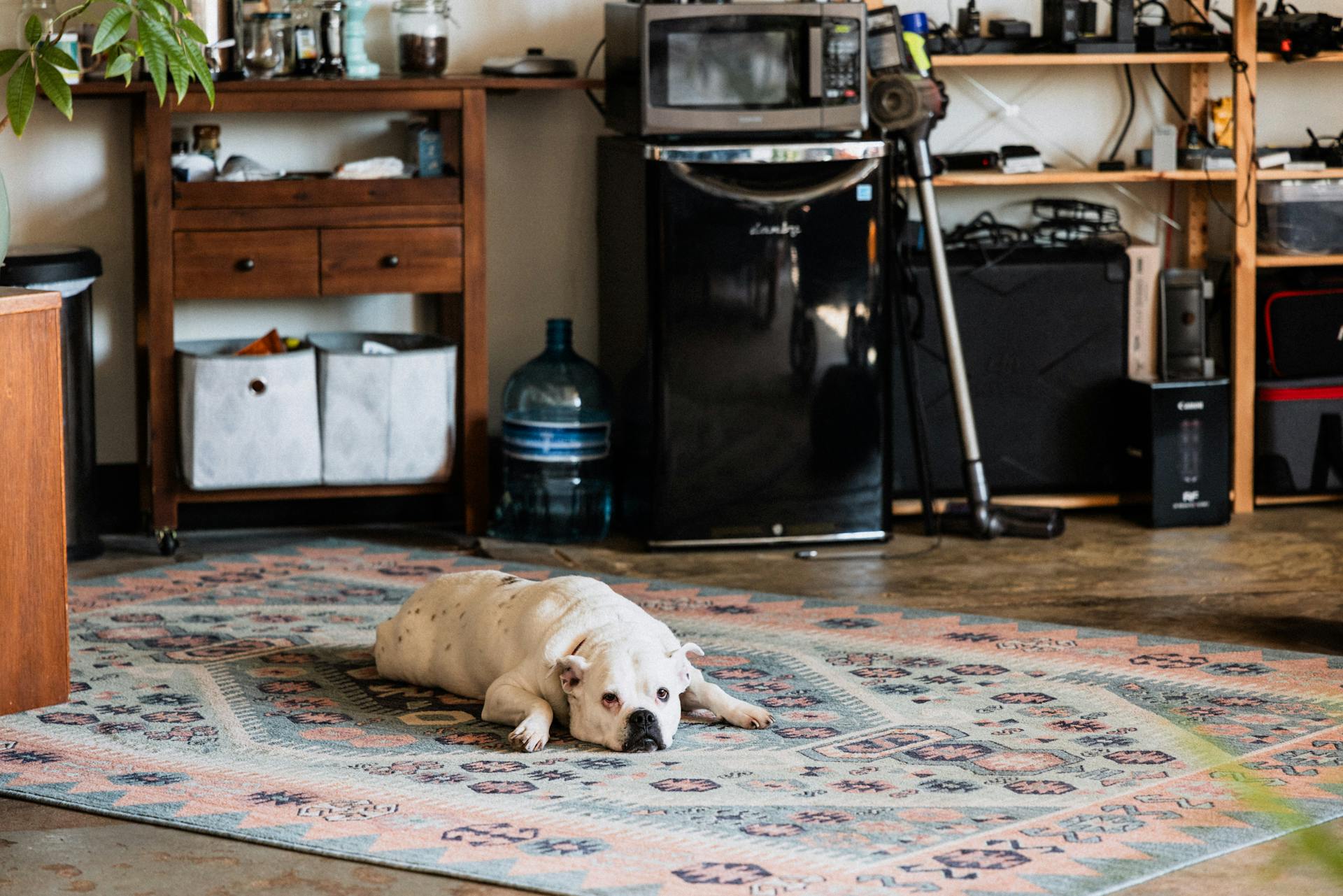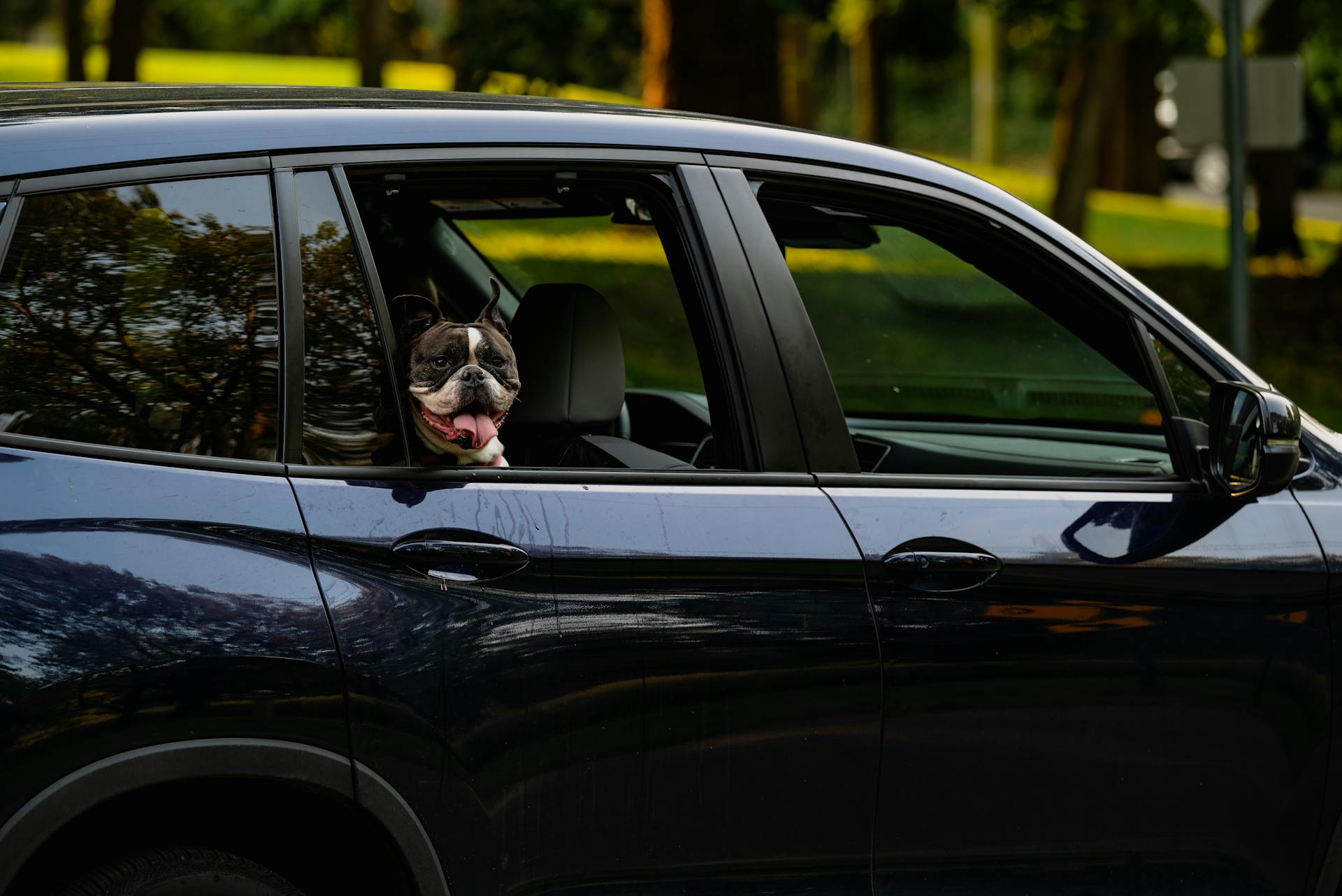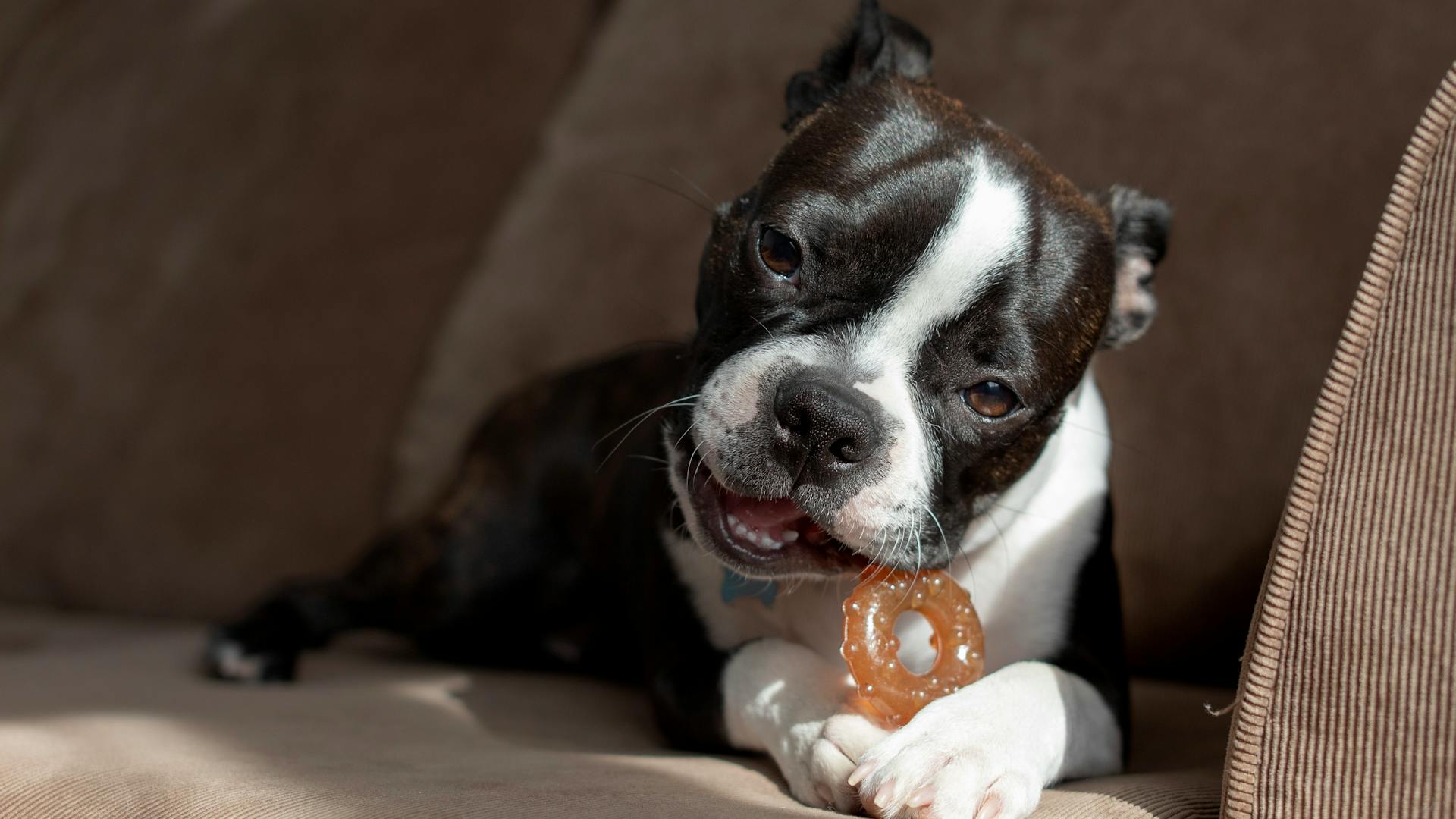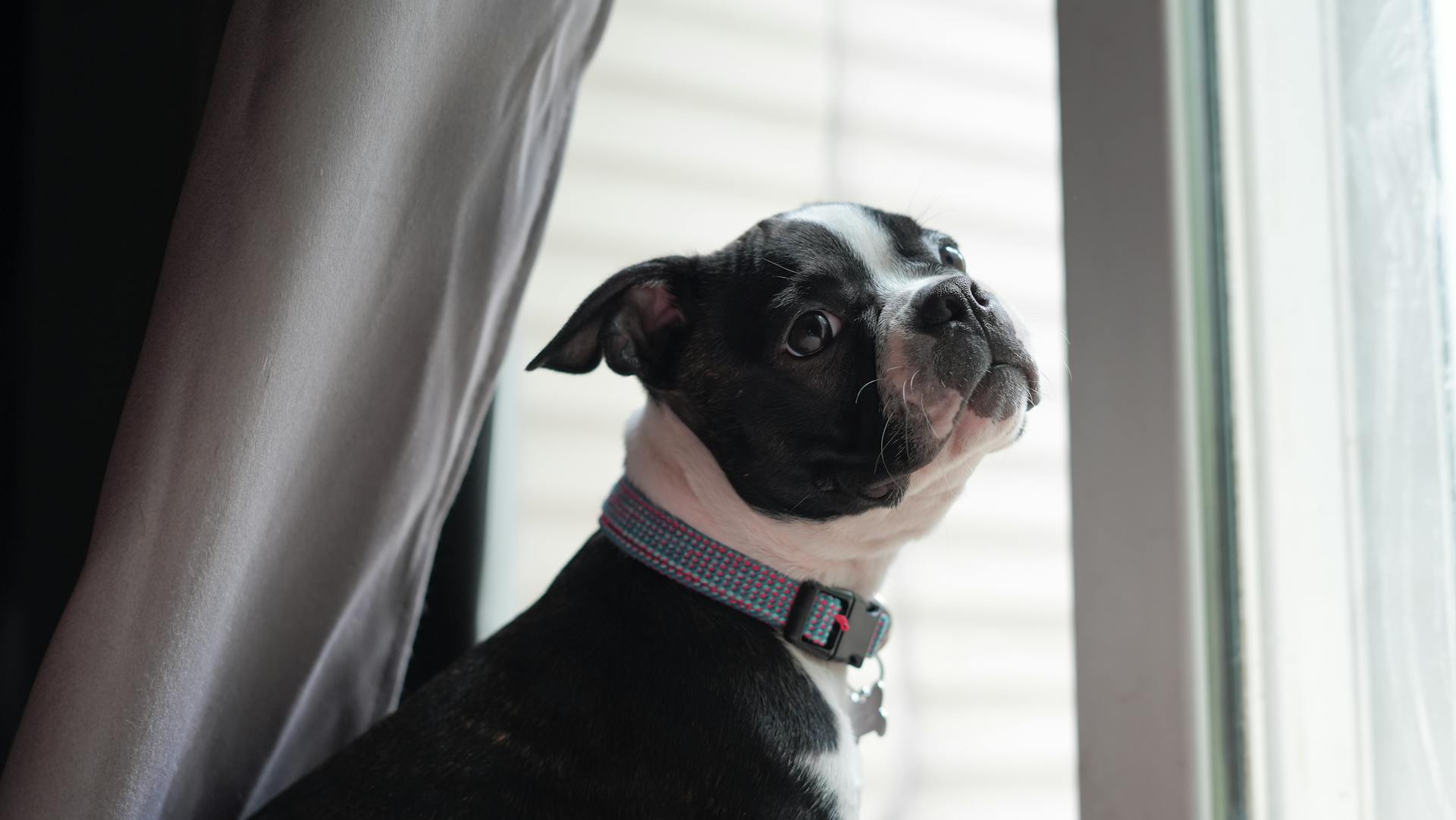
Boston Terriers have been a popular breed in dog shows for over a century. Their gentle and even-tempered nature makes them a crowd favorite.
In the late 19th century, the Boston Terrier was first recognized as a distinct breed by the American Kennel Club (AKC). This recognition marked the beginning of the breed's success in dog shows.
Boston Terriers typically weigh between 10-25 pounds and stand between 10-15 inches tall at the shoulder. Their compact size makes them well-suited for small living spaces.
Their short coats require minimal grooming, but regular nail trimming and ear cleaning are essential to maintain their overall health.
Readers also liked: 10 Fun Facts about Chihuahuas
Physical Characteristics
The Boston Terrier is a lively, highly intelligent dog with a smooth coat. They have a compact build and a short tail.
Their ears are small and can be either left natural or cropped to conform to the shape of their head. They are carried erectly and situated near the corners of the skull.
A Boston Terrier's ideal expression is alert and kind, indicating a high degree of intelligence. They convey an impression of determination, strength, and activity with a high order of style.
Head
The head of the dog is in proportion to its size, which is a notable characteristic.
The head's expression is a giveaway of its high intelligence, a trait that's truly impressive.
A well-proportioned head is a sign of a healthy dog, and it's something to look out for when assessing a dog's overall health.
Suggestion: Bull Terrier Head Shape
Eyes
The eyes of this breed are truly distinctive, with large, round eyes that are dark in color and wide apart.
The eyes are set square in the skull, giving them a unique and alert appearance.
The outside corners of the eyes are on a line with the cheeks when viewed from the front, adding to their endearing expression.
The breed's alert, kind expression is an important characteristic, making it a pleasure to be around these animals.
Eyes showing too much white or haw are considered faults in this breed.
Any trace of blue in the eyes is a disqualification, making it crucial to ensure their eyes are a healthy, dark color.
Worth a look: Yorkshire Terrier Eyes
Ears
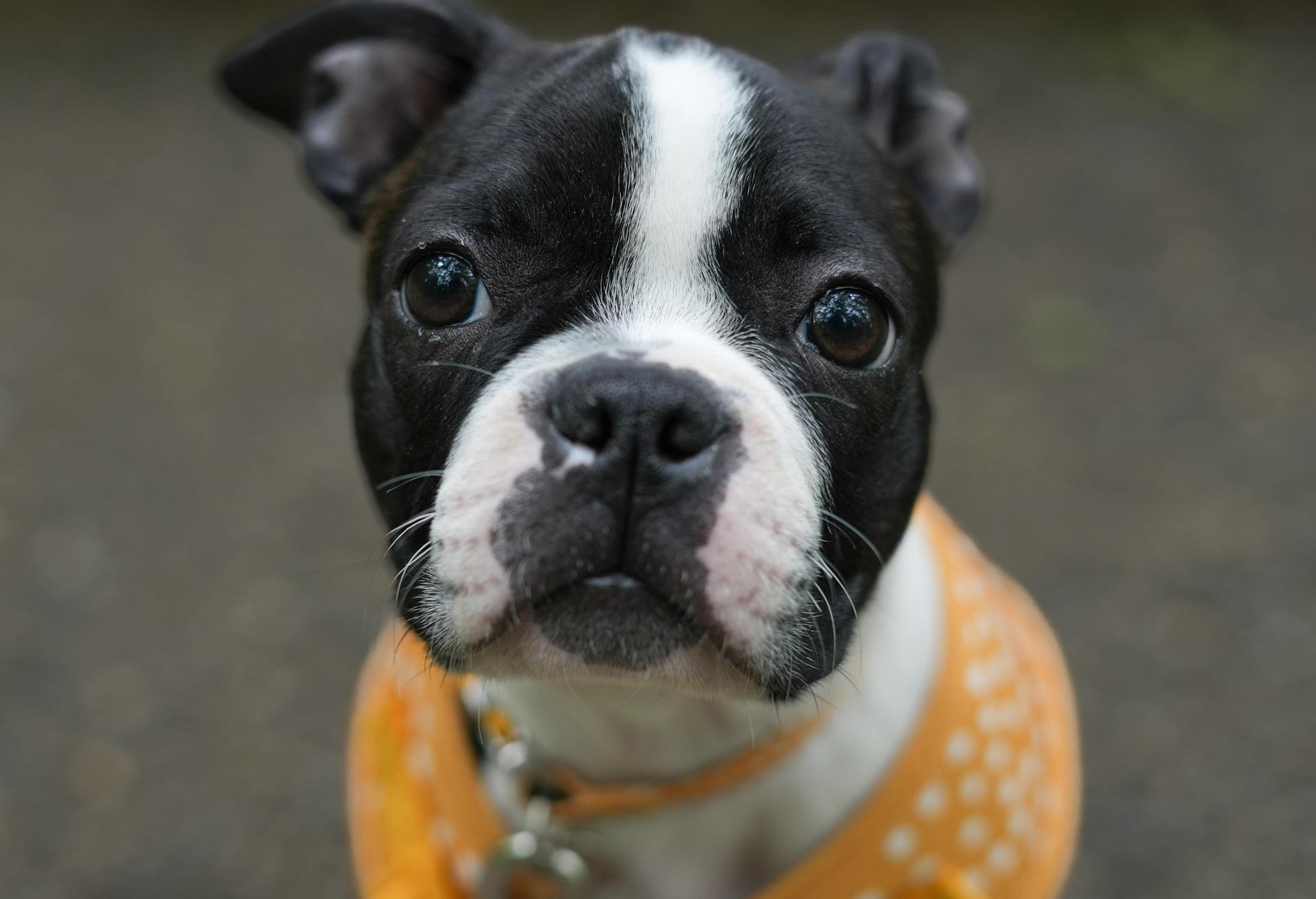
The ears are carried erectly and situated as near to the corners of the skull as possible.
Ears that are too small can be left natural or cropped to conform to the shape of the head.
General Appearance
The Boston Terrier's general appearance is a perfect blend of style and substance. They are a lively, highly intelligent, smooth coated, short-headed, compactly built, short-tailed, well-balanced dog.
Their sturdy build must not appear spindly or coarse, with bone and muscle in proportion to their weight and structure. This balance gives them a striking, square appearance.
The length of leg must balance with the length of body for that square look. Strong limbs are neatly turned, and the tail is short.
A proportionate combination of color and white markings is crucial in determining the overall appearance of the dog. This is particularly important when evaluating the relative value of general appearance to other points.
The Boston's general appearance is refined in the bitch's conformation, but the only noticeable difference is that refinement.
Color
The Boston Terrier's color is a crucial aspect of its breed standard. Boston Terriers can have either black, brindle, or seal coats, with the latter having a red cast when viewed in the sun or bright light.
Brindle is the preferred color, but only if all other qualities are equal. Seal and black coats are acceptable, but they must have the required white markings.
The required markings include a white muzzle band, a white blaze between the eyes, and a white forechest. These markings are a must-have for the breed standard.
A white collar and white on part or whole of the forelegs and hind legs below the hocks are considered desired markings. However, a dog with a preponderance of white on the head or body must have sufficient merit to counteract its deficiencies.
Disqualifications include solid seal, black, or brindle without the required white markings, as well as gray or liver colors and albinism.
Here's an interesting read: American Bully Coats
Body and Movement
The Boston Terrier's body is rather short and well-knit, with a level topline and a rump that curves slightly to the set-on of the tail.
A deep and wide chest is a hallmark of the breed, with well-sprung ribs that are carried well back to the short, strong loins. The flank is very slightly cut-up.
In terms of movement, a Boston Terrier's gait is sure-footed and straight, with forelegs and hind legs moving in perfect rhythm.
Body
The body of a well-bred animal is rather short and well knit.
The back should be just short enough to square the body, creating a level topline.
A slight curve in the rump is acceptable, as long as it's in line with the set-on of the tail.
The chest should be deep and wide, with well-sprung ribs that are carried well back to the loins.
The flank should be very slightly cut-up, but not excessively so.
Roach back, sway back, and slab-sided are all serious faults to avoid.
Curious to learn more? Check out: Boston Terrier Back Leg Problems
Gait
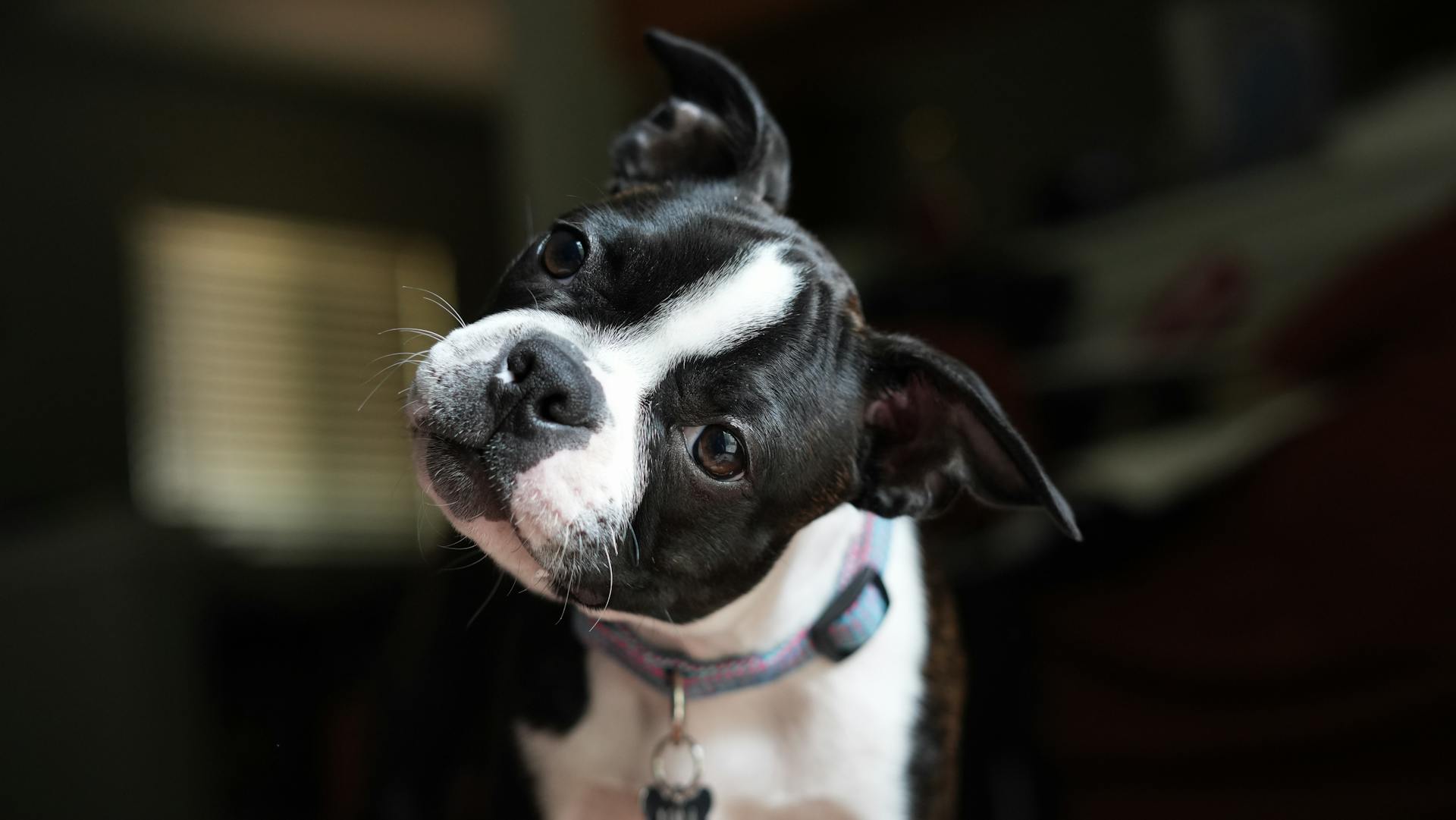
The gait of a dog is a crucial aspect of its overall movement. A well-balanced gait is essential for a dog's comfort and athletic ability.
The Boston's gait is characterized as sure-footed and straight-gaited, with forelegs and hind legs moving in perfect rhythm. This indicates grace and power in its movement.
Any crossing movement, whether front or rear, is considered a serious fault in a dog's gait. This can affect its balance and overall movement.
Rolling, paddling, weaving, and hackney gait are also considered faults in a dog's gait. These movements can be indicative of underlying issues or poor training.
Broaden your view: What Dogs Are Considered Pit Bulls
Notable Features
The Boston Terrier's large, prominent pair of eyes is a distinguishable feature.
Their round eyes are set widely apart, are large in size, and located squarely in the skull. This unique feature makes them stand out in a crowd.
Boston Terriers are also known for their short tails, which can take the shape of a corkscrew, or curl, or be straight. Generally, these tails do not exceed 2 inches in length.
Readers also liked: How to Clean Maltese Dogs Eyes
Temperament
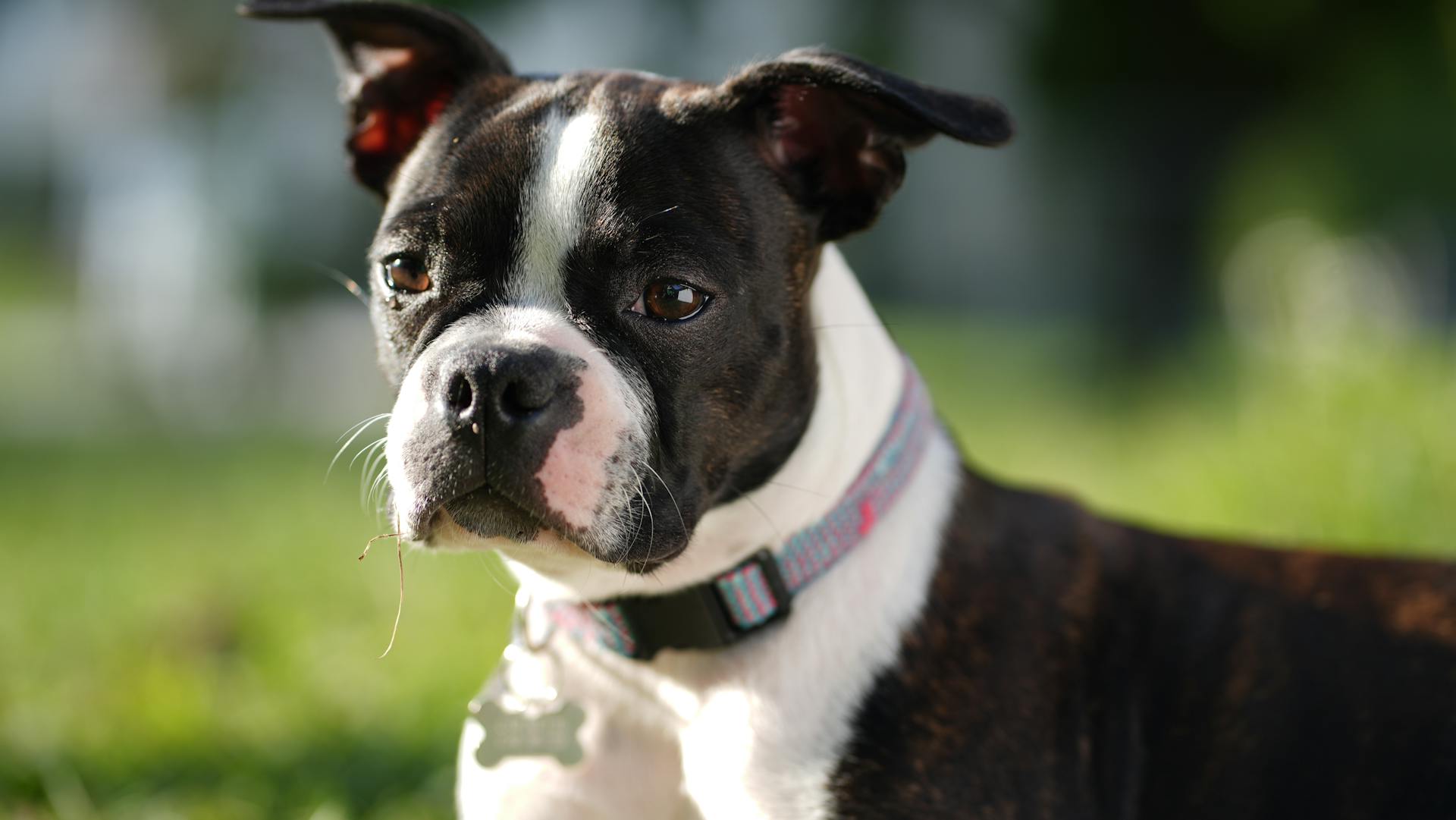
Boston Terriers are known for their lively and playful personalities, making them ideal companions for people of all ages.
They're also loving and demonstrative, happy to snuggle up in a comfortable lap and provide endless affection.
In fact, they're often described as "gentle" and "happy-go-lucky", with a strong sense of humor that's sure to bring a smile to your face.
Despite their small size, Boston Terriers can be quite protective of their owners, which may lead to aggressive behavior towards other pets and strangers.
However, with proper socialization, they can get along well with children, the elderly, other canines, and even non-canine pets.
Boston Terriers are generally quiet and only bark when necessary, making them a great choice for apartment dwellers.
In fact, their sensible attitude towards barking is one of the reasons why they're often recommended for city living.
Here's a quick rundown of Boston Terrier traits:
- Lively and playful
- Loving and demonstrative
- Happy-go-lucky and gentle
- Protective of owners
- Generally quiet
- Easy to train
Teeth
A full complement of strong, white, regular teeth is essential for a well-proportioned muzzle.
The teeth should meet in an even bite or one that is sufficiently undershot to square the muzzle.
Any showing of the teeth when the mouth is closed is considered a serious fault.
A fresh viewpoint: Black Mouth Cur Teeth
Notable Features
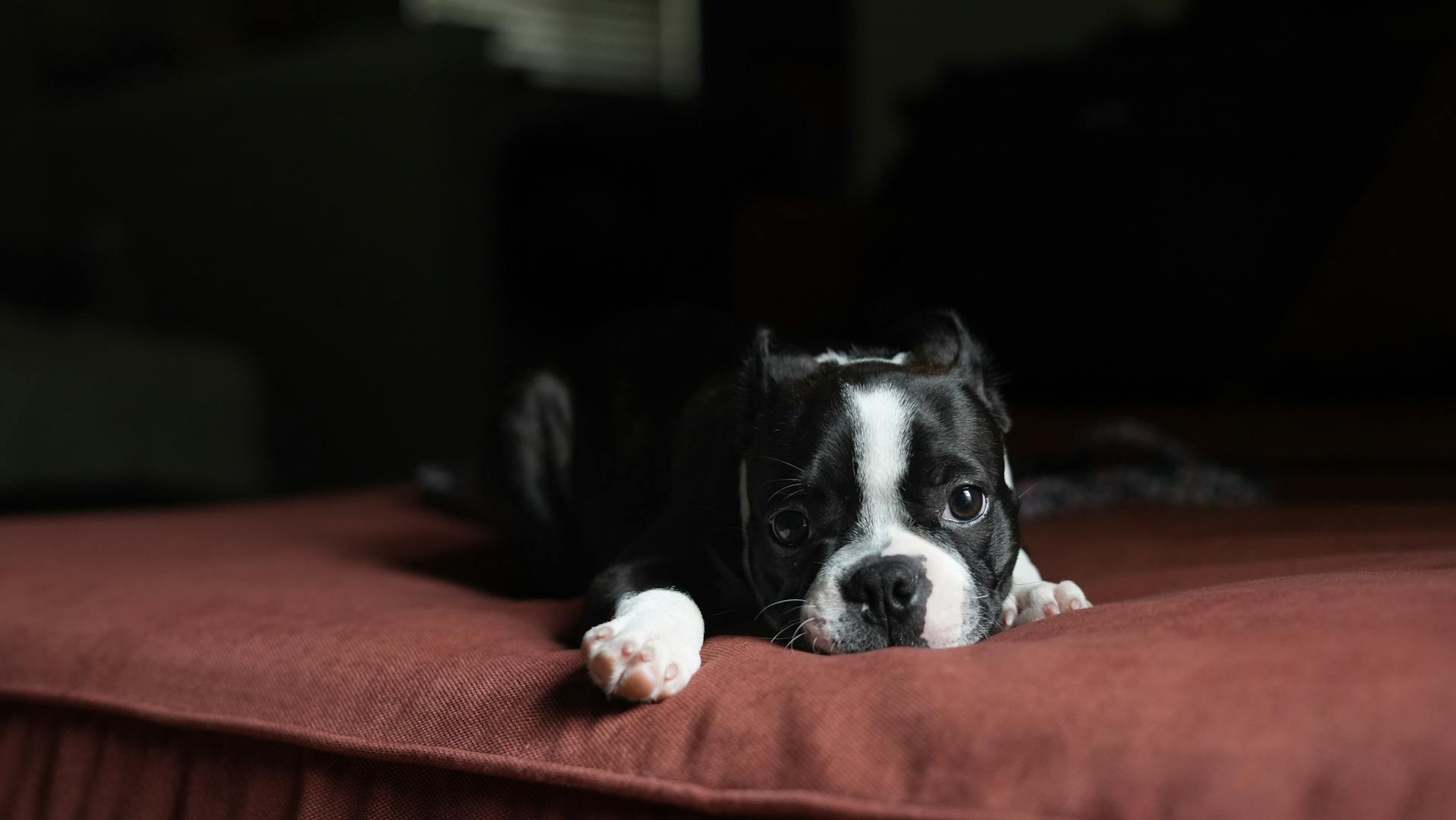
One of the most distinctive features of the Boston Terrier is its large, prominent eyes, which are set widely apart and located squarely in the skull.
Boston Terriers are known for their short tails, which can take the shape of a corkscrew, curl, or be straight, and generally don't exceed 2 inches in length.
Sergeant Stubby, a Boston Terrier, was a war hero who earned a gold medal from the U.S. Army and a medal from France for his service in World War I.
The breed's short tail is a result of its genetic makeup.
Classification and Recognition
The Boston Terrier's classification in dog shows is a bit of an enigma. The breed likely landed in the Non-Sporting Group because it wasn't fit for any of the other groups.
The Boston Terrier shares a similar lineage with the Bulldog and French Bulldog, which may have influenced the club's decision to categorize them together. This shared lineage is a key factor in their classification.
A different take: Dogs Breeds That Start with B
The breed's lack of a specific purpose, such as rat control or bullfighting, may have kept it out of the Toy Group. Boston Terriers are small enough to join the Toy Group, but they were not bred strictly as companions.
Their tenacious attitude and affinity for small prey, however, would have made them a good fit for the Terrier Group. But the Boston Terrier's intended purposes and abilities don't quite align with those of the breeds in this group.
Why Is the Boston Terrier in the Non-Sporting Group?
The Boston Terrier's classification in the Non-Sporting Group is a bit of an enigma. Unfortunately, no official records explain why the breed ended up in this group.
The Boston Terrier shares a similar lineage with the Bulldog and French Bulldog, which may have influenced the club's decision to categorize them all in the same group.
Unlike the Bulldog, the Boston Terrier was not bred with a specific purpose in mind, such as bull-baiting. This lack of a specific purpose may have contributed to its classification in the Non-Sporting Group.
A fresh viewpoint: Bull Terrier Purpose
The Boston Terrier was created by crossing Bulldogs with other breeds, including the White English Terrier, which is the descendant of the modern-day Bull Terrier. This breeding history is likely what set the Boston Terrier apart from other breeds.
The breed's non-specific uses, such as rat control and possible bullfighting, are likely what kept it out of the Toy Group. Weighing in under 25 pounds, the Boston Terrier was small enough to join the Toy Group, but its uses were not strictly as a companion.
Why Isn't the Boston Terrier Included?
The Boston Terrier's classification can be puzzling, especially when you consider its physical similarities to breeds like the French Bulldog and Bulldog. These breeds were all created using similar types of dogs.
However, the Boston Terrier's intended purpose is the main reason it's not included in the Terrier Group. Terriers were bred for vermin control.
Their tenacious attitude and affinity for small prey made this the apparent group for breeds like the Jack Russell Terrier, Cairn Terrier, and the Scottish Terrier. The Boston Terrier's history doesn't quite match up with these characteristics.
The main difference in breeds is their intended purposes and how well they retained their abilities to perform those tasks.
Frequently Asked Questions
Has a Boston Terrier ever won the Westminster Dog Show?
Unfortunately, there is no record of a Boston Terrier winning the Best of Breed title at the Westminster Dog Show. However, a Boston Terrier named Sparrow has won Best of Breed in another prestigious competition
What two dogs make a Boston Terrier?
The Boston Terrier is a cross between an English Bulldog and a white English Terrier. This unique heritage gives the breed its distinctive appearance and characteristics.
Is the Boston Terrier in the National Dog Show?
Yes, the Boston Terrier is featured in the National Dog Show, specifically competing in the Non-Sporting Group. Watch them strut their stuff on the show's 2023 broadcast.
Featured Images: pexels.com
